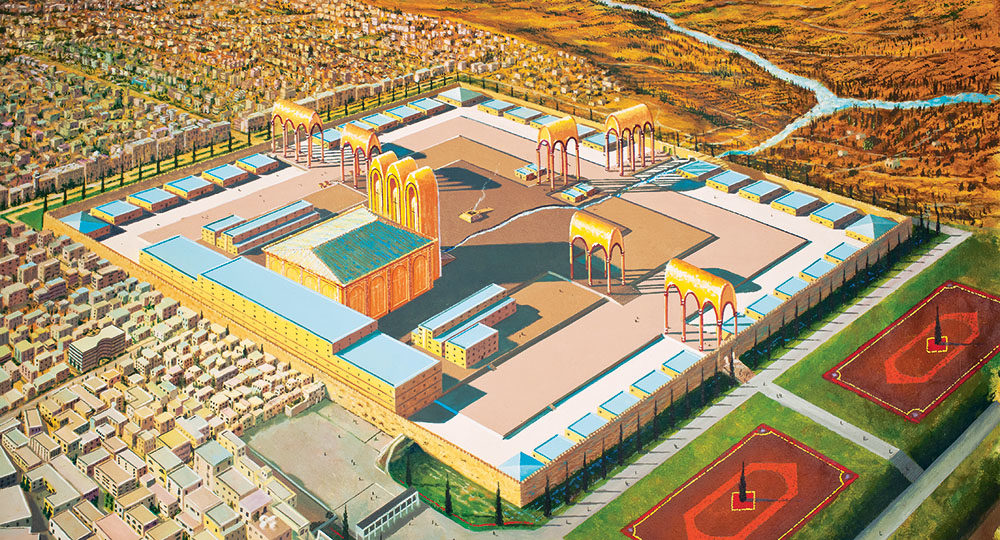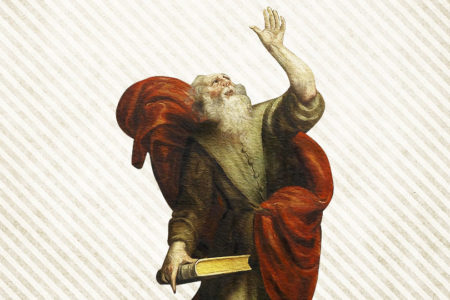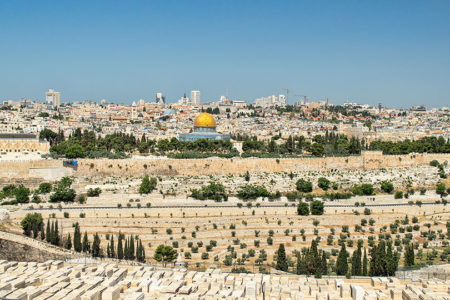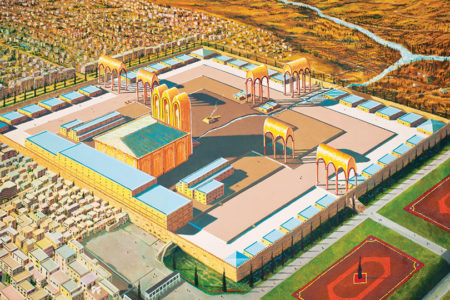The Millennial Temple
Soon after the Lord delivered the children of Israel from their bondage in Egypt, He gave Moses instructions to build the Tabernacle. The work was done according to God’s plan, and when it was completed, the glory of God dwelt in the Holy of Holies among His people.
After several centuries, the Tabernacle grew old. David wanted to build a permanent dwelling for the Lord, but God would not permit him to do so. Instead, God appointed David’s son, Solomon, to build the first Temple, and the Lord chose to grace it with His presence. But because of the idolatry that swept through the land of Israel in the ensuing years, the glory of God eventually departed from that Temple (Ezek. 8—11), and the building was destroyed by the Chaldeans.
The Second Temple was built by Zerubbabel after the Jewish people returned from their Babylonian captivity. Later, Herod made major renovations and improvements to that Temple, which took many years to complete. It was in this Temple that Jesus ministered. There is a significant distinction between Solomon’s Temple and the Temples of Zerubbabel and Herod: There is no biblical record that God ever manifested His shekinah glory or dwelt in the latter two.
Scripture teaches that there will be two more Temples in Jerusalem in the future. The first is implied, but the second, or Millennial Temple, along with its worship system, is clearly described in Ezekiel 40—48.
Implications concerning the third Temple are given in several passages. The first, Daniel 9:24–27, describes the 70 weeks of years given to the Jewish people. In verse 27, Daniel spoke of the 70th week, known as the Tribulation period, and the Antichrist. In the middle of the week, this wicked one will “cause the sacrifice and the oblation to cease, and for the overspreading of abominations he shall make it desolate.” To have a sacrificial system, some type of Temple will have to be built. In Matthew 24:15, Jesus implied an existing Temple when He spoke of the abomination that makes it desolate.
The fourth Temple will be built in Jerusalem at the time of the thousand-year reign of Christ, which is the subject of the last nine chapters of Ezekiel and the basis of the remainder of this article.
The Promise of the Millennial Temple
In context, Ezekiel 36 and 37 speak of the day when the Lord will bring the Jewish people back to their land (36:24; 37:1–12). He reassured them that they will turn to the Lord then and that He will put His Spirit within them.
Concerning a future Temple, the Lord promised in 37:26, 28, “I will … set my sanctuary in the midst of them for evermore,” and “my sanctuary shall be in the midst of them for evermore.”
We can draw several conclusions from these verses. The promises are given for a time still future, after Israel returns to the land and looks to the Lord in a national day of repentance. The sanctuary mentioned will last for a long time. It could not, therefore, refer to the Temples of Zerubbabel or Herod, for those Temples were short-lived. Furthermore, Israel as a nation had not then turned to the Lord (Zech. 3:9). We can therefore conclude that the Temple of which the prophet wrote is the Millennial Temple, the one that will be in existence when our Lord rules over the earth.
Ezekiel devoted more than one-sixth of his writing to a description of the Millennial Temple, the details of its worship procedures, and the operation of its priests, so that when it is eventually erected, its functions will be carried out as He has directed.
Some theologians feel that Ezekiel is not describing a literal building, but, rather, the vision of a figurative one. Considering, however, that Solomon’s Temple was a literal building that was literally destroyed, and that the regathering of the Jewish people back in their homeland is literally being fulfilled, we cannot assume that the last nine chapters of the book are figurative. The possibility of the Millennial Temple as a literal building must be considered.
A sacrificial system will be reinstituted, somewhat similar to that of the Old Testament, but with some changes. The sacrifices will be commemorative and retrospective. They will point to the efficacy of the completed and all-sufficient work of Christ’s death at Calvary.
The Old Testament sacrifices did not save; rather, they looked forward and pointed to the atoning work of the cross. The millennial sacrifices will, in the same manner, point back to Christ’s death as an accomplished fact and serve as a reminder of the salvation that all Israel will then know (Rom. 11:26–36).
The church celebrates the ordinance of the Lord’s Supper. It does not add to the work of Christ at Calvary but serves as an illustration and a reminder of the all-sufficient work of our Lord. The sacrificial ritual in the Millennial Temple will remind the Jewish people of the work of Christ on the cross when the kingdom is restored to Israel.
The Plan of the Millennial Temple
This Temple will be built in Jerusalem somewhere near the site of the previous Temples. However, it will be much larger than any of its predecessors.
Ezekiel was told to pay attention to everything that was being shown to him and to “Declare all that thou seest to the house of Israel” (Ezek. 40:4). The Lord showed these things to the prophet so that he could encourage the Jewish people concerning their final restoration in the kingdom.
A wall will surround the Temple area. Each side will be approximately 875 feet long; 10 feet, 4 inches high; and 10 feet, 4 inches wide. The wall will protect the area from defilement from those outside the walls. Scripture teaches that this will be a very sacred place to the Lord, and the wall connotes separation from sin. The blessings of the Lord will flow from this building. In like manner, we who are in Christ are to be separated from sinful practices and live lives holy unto our Savior.
Three gates will lead into the outer court of the Millennial Temple. Apparently they will all be the same, although Ezekiel describes only the one on the eastern side. There will be no gate on the western wall. The gates will be similar to those built by Solomon, which were excavated at Gezer, Hazor, and Megiddo. The shekinah glory of God will enter the Temple by the east gate (43:1–6), and that gate will then be closed in honor of that marvelous event.
An outer court, approximately 875 feet long on the sides and 175 feet wide, will surround the Temple on three sides. On the inside of the outer walls will be 30 rooms facing the outer court. The purpose of these rooms is not clearly stated, but they may be used for storage or as meeting rooms for those who come to celebrate the feasts during the Millennium (Zech. 14:16–17).
Inside the inner court will be an area with tables set up on each side of the gate. Here the sacrifices will be prepared to be offered on the altar. There will also be two rooms for the priests—one for those responsible for the Temple, and the other for those responsible for caring for the altar.
Ezekiel then was taken to the outer sanctuary (being a priest, he was permitted to be there), but only the angel entered the inner sanctuary to measure it. Around the outside of this Temple there were three levels of side rooms with 30 rooms on each floor.
Although Ezekiel had seen the glory of the Lord depart from the Temple (ch. 8—11), he was permitted a glimpse into the future to see that glory return from the east, enter through the gate, and go into the inner sanctuary. God promised that when this finally occurs, that new Temple will be the place of His throne, and He will live among the Jewish people forever (43:7)—it will be God’s dwelling place among His people and will never again be defiled.
It will take seven days of ritual to consecrate the altar unto the Lord. This will be accomplished by the priests of Zadok, heirs of the priests who remained steadfast to the Lord and the Temple during the days of Solomon. They will serve as judges and will not inherit any land because the Lord will be their inheritance and will care for them.
The Changes in the Land
A unique feature of the Millennial Temple will be a river flowing out from under its threshold toward the east. The waters will divide, with one half going toward the Dead Sea and the other half toward the Mediterranean Sea (Zech. 14:8). The waters will gradually deepen and bring life in the form of trees, fish, etc. This life-giving water will be a constant reminder of the presence of God and His blessings.
The land of Israel will be enlarged to encompass Tyre and Sidon on the Mediterranean, Damascus to the north and east, and spread down to the sea Galilee, past the Dead Sea, swing around to the Wadi of Egypt, and back to the Mediterranean.
Each tribe will be given a portion of land. Seven tribes will be situated to the north. A central section will be allotted to the prince, the priests, the Levites, the city of Jerusalem, and farm and pasture land. The southern portion of the land will be given to the remaining five tribes. All segments will stretch from the Mediterranean to the eastern border of the land.
Ezakiel 48:35 says of the land of Israel in that future day, “The Lᴏʀᴅ is there.” What a fitting climax for a book that takes God’s people from the depths of despair during the Babylonian captivity to the visible presence of the Lord among His redeemed people, ruling the world in justice, righteousness, and peace.









The wooden objects(table, etc) do not appear to be covered in gold..do you think they will be?
Have been a financial supporter of Israel
My Glory for about 40 or 50 yrs..thank you for all of your fundamental Bible knowledge imparted to those who receive “Israel My Glory “..this online summary of Ezekiel was no exception
What will the christians, who were raptured, be doing during the millennium? The 4th temple will not be just for the Jews, right? That is a troubling thought to me.
That is a great question! I have had that same thought myself. I look forward to hearing an answer.
We will ALL be there.
As it relates to the sacrifices being simply a memorial action as is the Lord’s supper during the Church Age. We are commanded to have the Lord’s supper only until He comes. It will then be unnecessary for He will be present. Why then will Israel need to be reminded of that which they will have personally visible? They will have Him. In the New Jerusalem there will be no temple for He will be our temple. Rev 22.
The people in Millenium are not perfect. They still have their free will to choose sides. Rev 20:7-8 says, Satan will be released and will go out to deceive the nations. Their numbers are like sand on the seashore. So, before Satan is released, these Millenium people need the rituals to remind them of Jesus sacrificial’s death for their salvation. Besides, the new generation born during the millennium, having spared from the tribulation, has a greater need to know about the commemorative sacrifices. There is no church or pastor to teach them the history of Jesus Christ on the cross.
After the millennium (Rev22), there is no need for a temple because the sheep are finally separated from the goats, and satan is eternally no more.
The Lord Jesus, The Righteous Branch has decreed that a Memorial is necessary for all the nations to remember His sacrifice through the presence of a Temple He will build, stated in Zechariah and through the actions and rituals of the priests he will appoint from both Jews and Gentiles. Isaiah tells us that in the Millenium, the Lord Jesus Christ will have priests chosen from both the Jews and some from the Gentiles.
I have a question, if Jesus will be on Earth during the Millennial Kingdom, why would we need a sacrificial system to remind us of what he did? At the time the Israelites will look at the one they pierced and mourn as in repent. So why would they need a reminder with sacrifices?
I would like to know who will occupy the land around Millennial Temple. Are they physical Israel descendants of 12 tribes.?. If so where do they come from ?. Are they spiritual Israel (gentiles) ?. If not what about us (non jews)
Ezekiel and Zechariah and even Genesis mentioned the nation of Israel as the inhabitants of the lands between the great sea or Mediterranean sea and the Euphrates river.
The rest of the world will be repopulated by survivors of the Tribulation of all gentile nations. Gentiles or at least their kings will have to travel to Jerusalem once a year to partake in the Feast of Booths or Tabernacles. This is also based on Noah’s prophecy about Shem and Japheth living under Shem’s tent. (See Ham’s sin story in Genesis.) Also read my previous reply to better understand the conditions the Millennial gentiles will live under.
I understand the notion of looking ahead and looking back at the Sacrificial Work of Christ to explain the animal sacrifices that occur during the Millennium. However, how do you account for the prophecy of peace with all the animal kingdom and Isaiah specifically saying – “they will neither harm nor destroy on all my holy mountain,” (Isaiah 11:6-9)? Killing animals for sacrifice is certainly harmful and destructive.
Now there’s a thought to ponder. I’d love to hear the answer.
Those sacrifices had been demanded by the Lord so they are acceptable by nature. It is no case of destruction for there is no violence, no plunder, no arson, etc. There are just priests performing their godly job.
Plus it is normal to keep symbols of what the Lord has done as illustrations. It helps them teach new generations of Jews and ignorant gentiles that will need to travel to Jerusalem once a year to partake in the Feast of Tabernacles. Keep in mind those gentiles cannot be compared with the Church. They won’t immediately become priests like we modern believers are, and that’s what actually entitle us nowadays to preach the gospel to the world thanks to Jesus Christ’s eternal grace. Once the Church is raptured, this pact will cease to exist as mentioned in Revelation when John describes how gentiles that repent during the 7 year tribulation will be executed by the sword (and any other modern weapon?). Yet, the New Testament revelations about Christ will be valid forever and ever.
What does Revelation 21:22 mean? “I did not see a temple in the city, because the Lord God Almighty and the Lamb are its temple”. This verse appears, to me, to contradict both Ezekial, the Millennial Temple will stand in the middle of the northern section of the new Jerusalem; and the presence of the Millennial Temple in Jerusalem at all.
Thank you
Great article. I really appreciate it. I had just read the book of Ezekiel and it caused me to wonder why sacrifices would be offered during the Millennial reign if Jesus’ death made temple sacrifices unnecessary. Your article pointed out that animal sacrifice was always just a picture of the real sacrifice of Christ and future Temple sacrifice is a reminder of the Real Sacrifice. This was a great help in understanding this. Thank you.